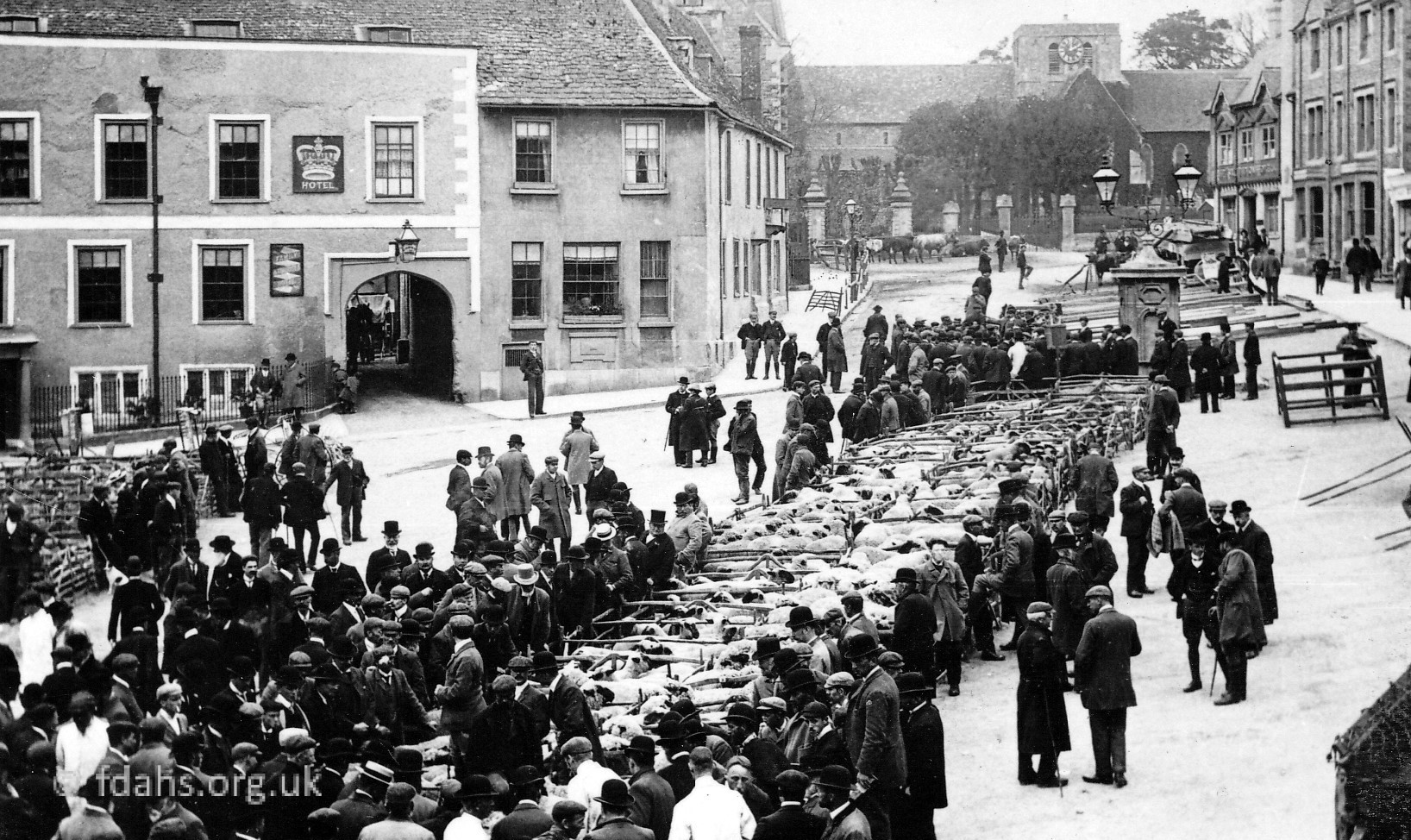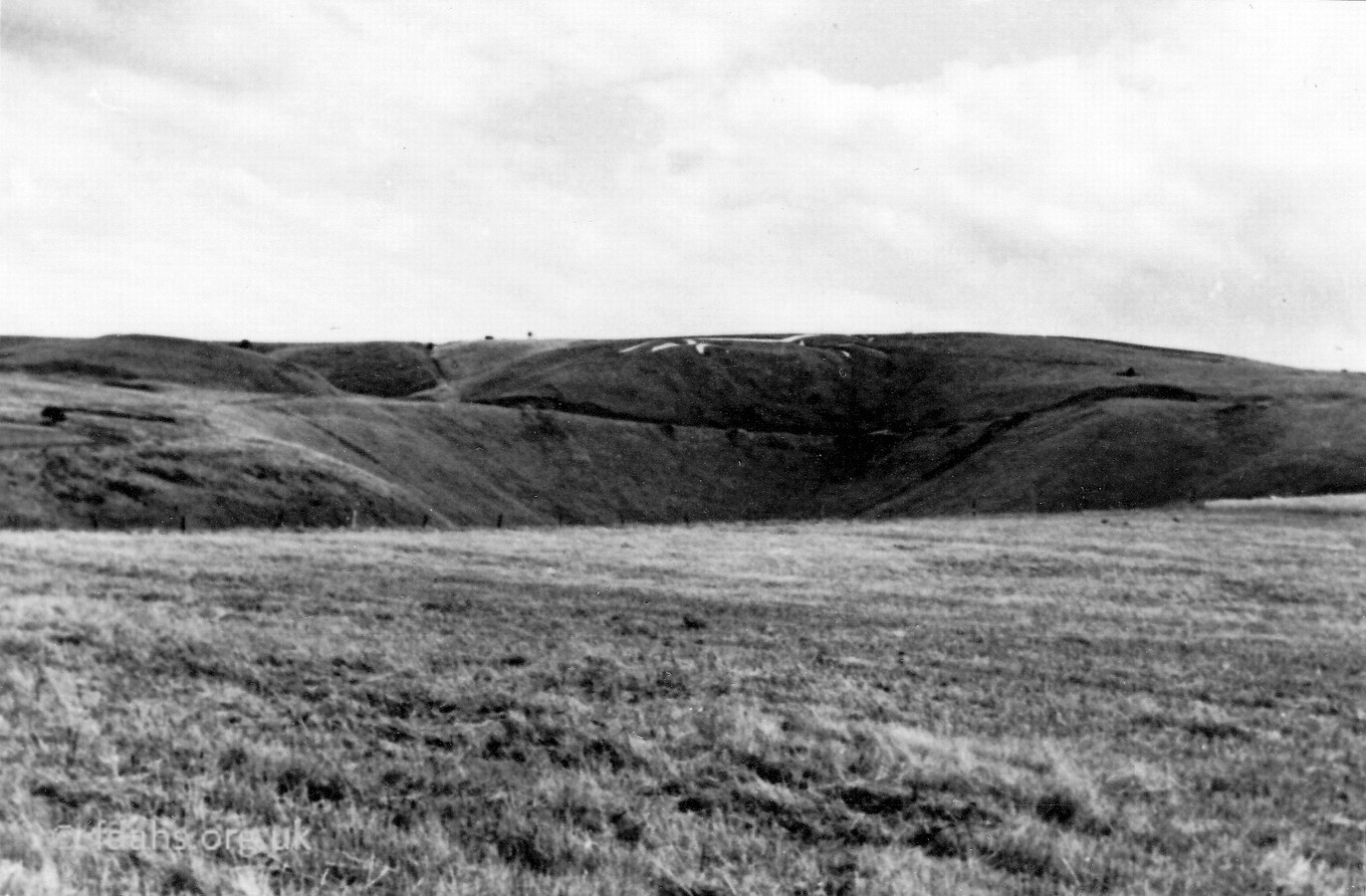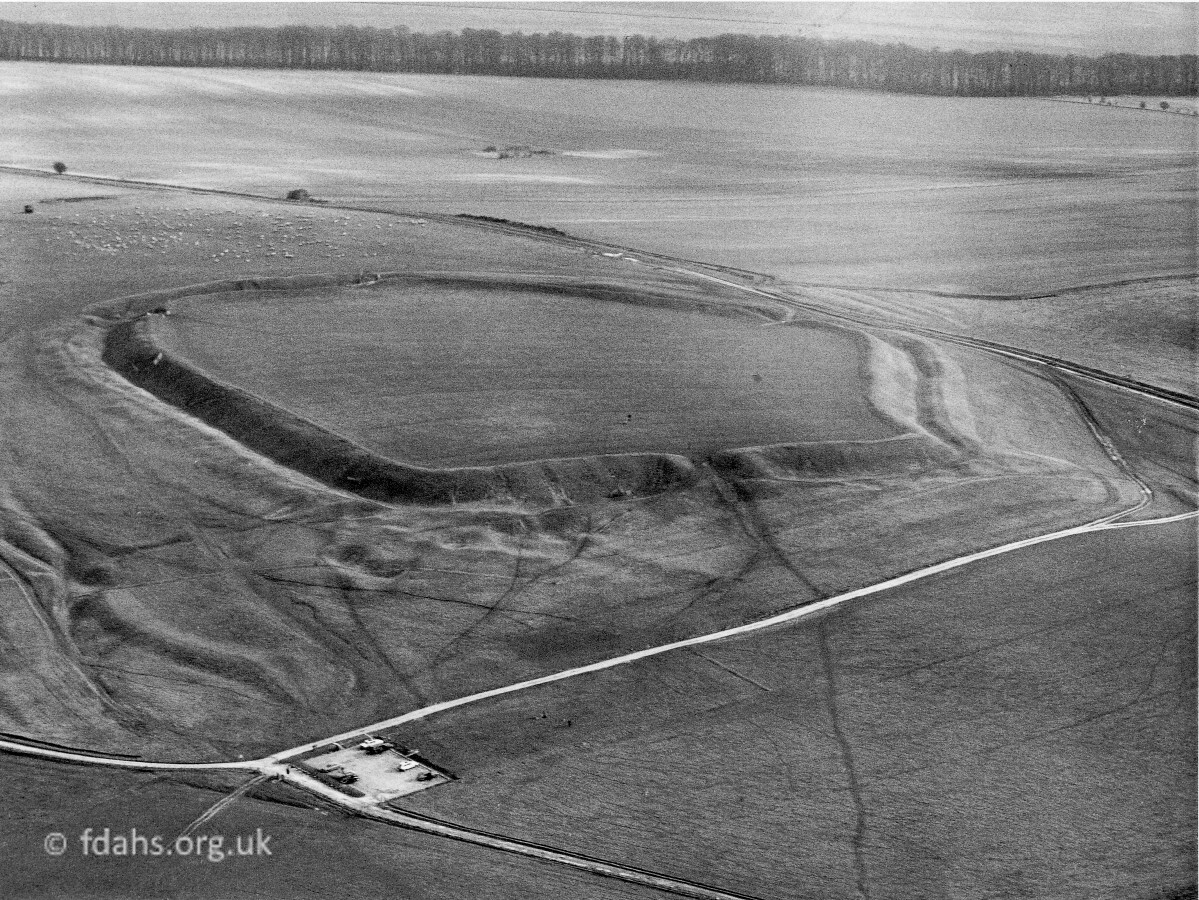Uffington lies about 5 miles south of Faringdon beyond the village of Fernham. An old Anglo-Saxon village whose name with its current spelling appears to date from c.955 – Uffa ‘personal name’; inga ‘people of’; tūn ‘enclosure, farmstead, village, estate’. It is written as Offentone in the Domesday Book 1086 and has had various spellings since.
The 2011 Census recorded the parish’s population as 783. The village has become famous for three things – the book ‘Tom Brown’s Schooldays‘, the ancient ‘White Horse‘ carved out on the nearby Berkshire Downs, and ‘Uffington Castle‘ an early Iron Age fort.
Tom Brown’s School
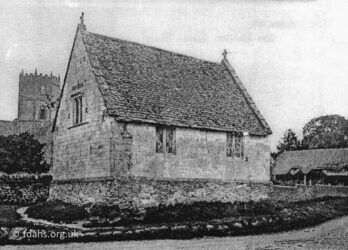
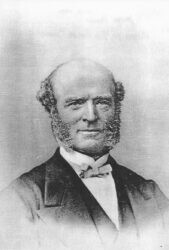 Tom Brown’s School on the corner of Fernham Road and Broad Street in the early 1880s. It was a village reading room at the time shown in this photograph. It was originally the village school, founded in 1617. Since 1984 it has become the village museum with exhibits on the history and archaeology of the area. The museum is run by volunteers, is financed entirely by donations, grants and membership fees, and remains free to visit. Notably the museum contains a collection of 137 editions of the well-known book “Tom Brown’s Schooldays”, written by Thomas Hughes who was born in Uffington in 1822. His father was rector. For some years, the village was also home to the much loved poet, Sir John Betjeman, who was a churchwarden there.
Tom Brown’s School on the corner of Fernham Road and Broad Street in the early 1880s. It was a village reading room at the time shown in this photograph. It was originally the village school, founded in 1617. Since 1984 it has become the village museum with exhibits on the history and archaeology of the area. The museum is run by volunteers, is financed entirely by donations, grants and membership fees, and remains free to visit. Notably the museum contains a collection of 137 editions of the well-known book “Tom Brown’s Schooldays”, written by Thomas Hughes who was born in Uffington in 1822. His father was rector. For some years, the village was also home to the much loved poet, Sir John Betjeman, who was a churchwarden there.
Uffington Village
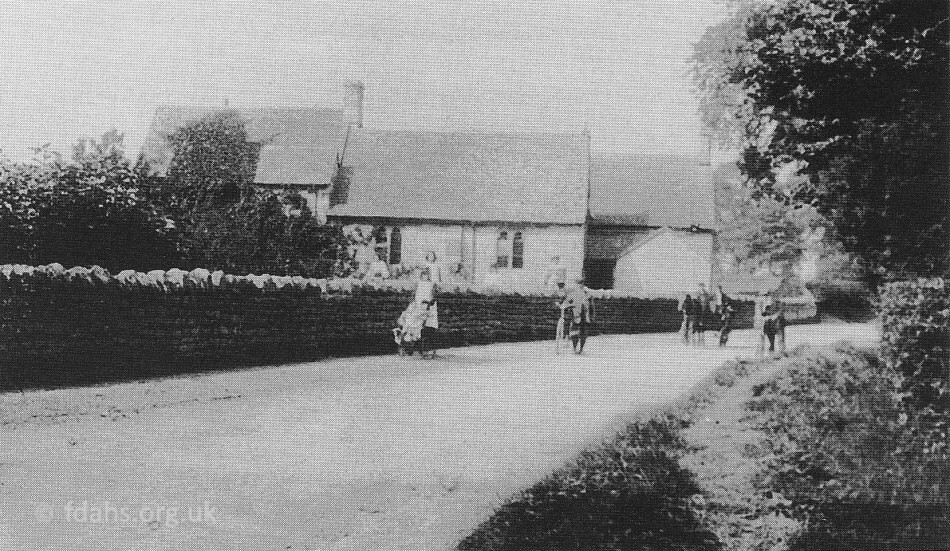 Broad Street in the 1920s or 1930s showing the new school with the schoolmaster’s house attached.
Broad Street in the 1920s or 1930s showing the new school with the schoolmaster’s house attached.
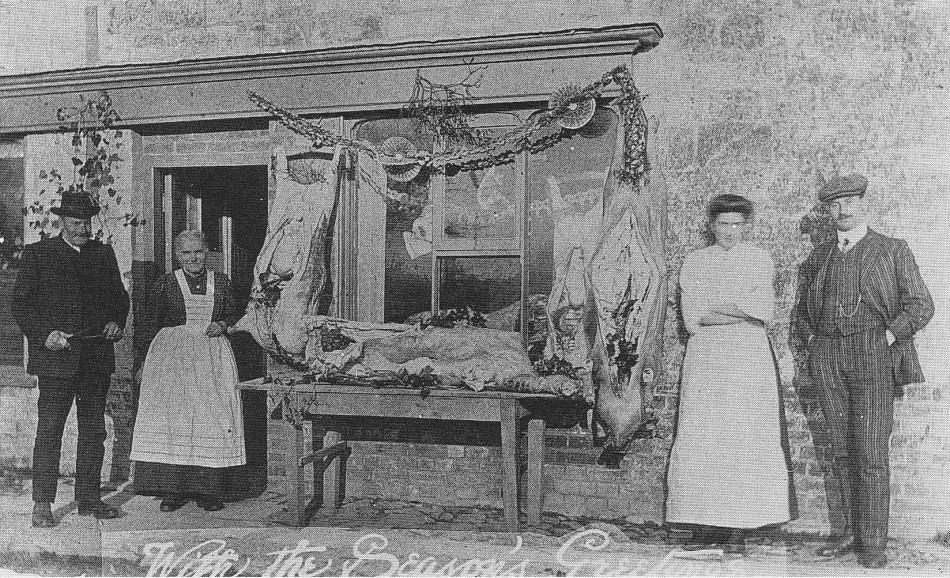 Butcher’s Shop. On the left are Mr James Pike and his wife Susannah standing outside their butcher’s shop. They had arrived from somewhere in the Midlands early in the 20th century. On the right are their daughter and son-in-law, Mr and Mrs Norton.
Butcher’s Shop. On the left are Mr James Pike and his wife Susannah standing outside their butcher’s shop. They had arrived from somewhere in the Midlands early in the 20th century. On the right are their daughter and son-in-law, Mr and Mrs Norton.
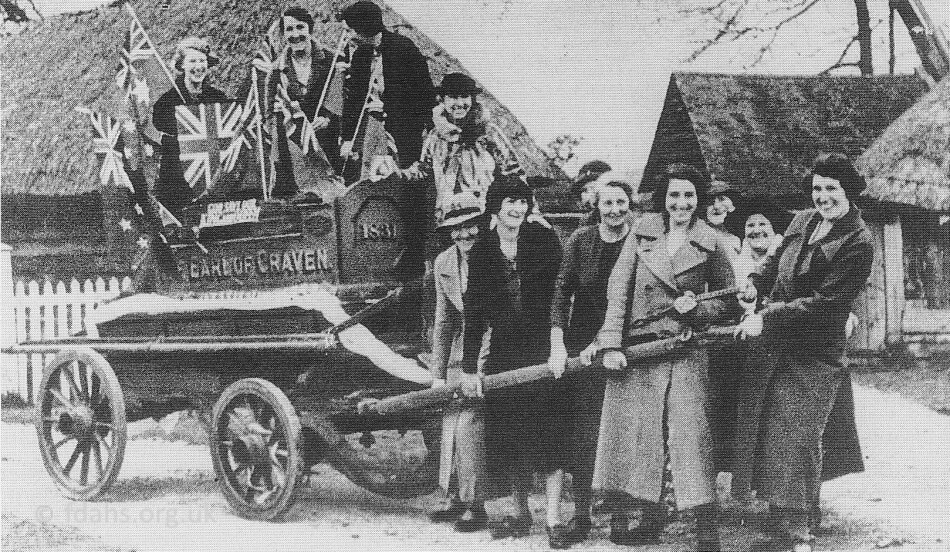 1937 Coronation Celebrations. The Craven Estate fire engine, which was kept in Uffington. A popular story in the village was that if you were single and had a ride on the fire engine you would be married within the year. The engine is preserved and kept at Newbury Museum. Left to right: Joyce Bowley; Mrs Queenie Weaver; Ettie Lewer; ?; ?; ?; ?; Mrs Dainty snr; Mrs George Weaver;?;?; Mrs Susan Packer.
1937 Coronation Celebrations. The Craven Estate fire engine, which was kept in Uffington. A popular story in the village was that if you were single and had a ride on the fire engine you would be married within the year. The engine is preserved and kept at Newbury Museum. Left to right: Joyce Bowley; Mrs Queenie Weaver; Ettie Lewer; ?; ?; ?; ?; Mrs Dainty snr; Mrs George Weaver;?;?; Mrs Susan Packer.
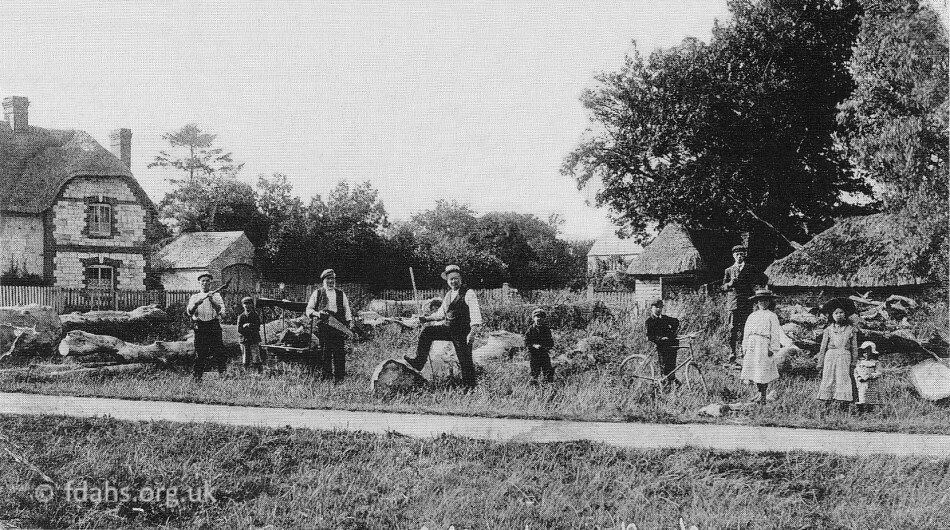 1890s. The Craven Estate timber yard, now known as ‘The Green’. The cottage on the left was the home of Mr and Mrs Dainty. He was an estate carpenter and wheelwright and strangely for a man of quite manual labour, also the village watch and clock mender. Later, moving with the times, he repaired gramophones as well. The small building next door housed the estate fire engine – a horse-drawn manual pump, which was a welcome insurance when so many of the village houses had a wealth of timber and thatch in their construction. Modem houses now stand on the edge of the green.3
1890s. The Craven Estate timber yard, now known as ‘The Green’. The cottage on the left was the home of Mr and Mrs Dainty. He was an estate carpenter and wheelwright and strangely for a man of quite manual labour, also the village watch and clock mender. Later, moving with the times, he repaired gramophones as well. The small building next door housed the estate fire engine – a horse-drawn manual pump, which was a welcome insurance when so many of the village houses had a wealth of timber and thatch in their construction. Modem houses now stand on the edge of the green.3
In the timber yard is a selection of tree trunks or ‘sticks’ as they were known. These would have been of oak, ash or elm. All the sawing was done by hand over a saw-pit. The sawyer stood on top of the log and guided the saw to the trunk line, while the labourer stood in the pit and pulled the saw down, getting covered in sawdust. The head of the yard, Mr Edmund Bailey is the man in the straw boater standing in the centre with his foot on a log and holding the measuring rod.
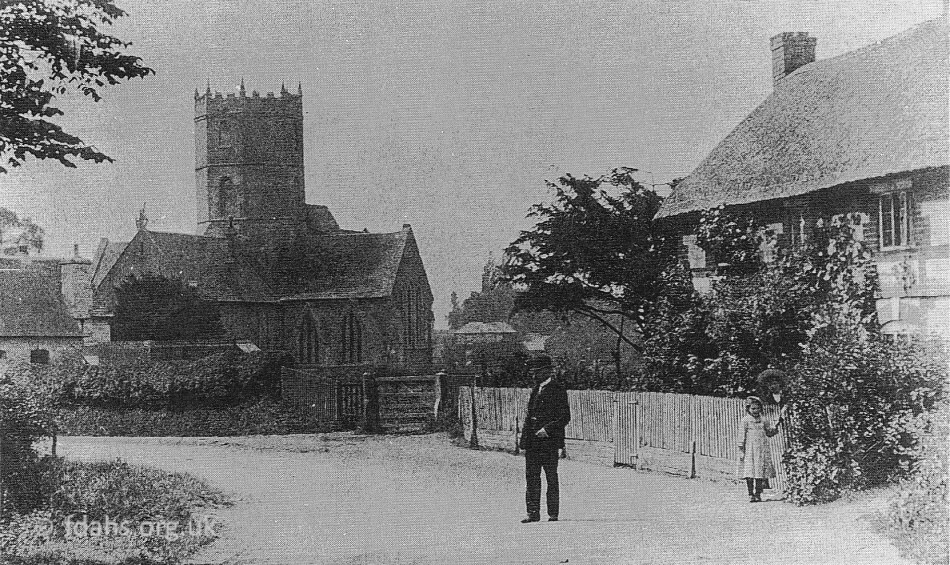 Broad Street pre-1907. The man is Mr Kosser who ran the Post Office and Village Store and was also the local postman. He was of German extraction and at the outbreak of the First World War, when there was a great deal of anti-German feeling, he changed the spelling of his name to Cosser.
Broad Street pre-1907. The man is Mr Kosser who ran the Post Office and Village Store and was also the local postman. He was of German extraction and at the outbreak of the First World War, when there was a great deal of anti-German feeling, he changed the spelling of his name to Cosser.
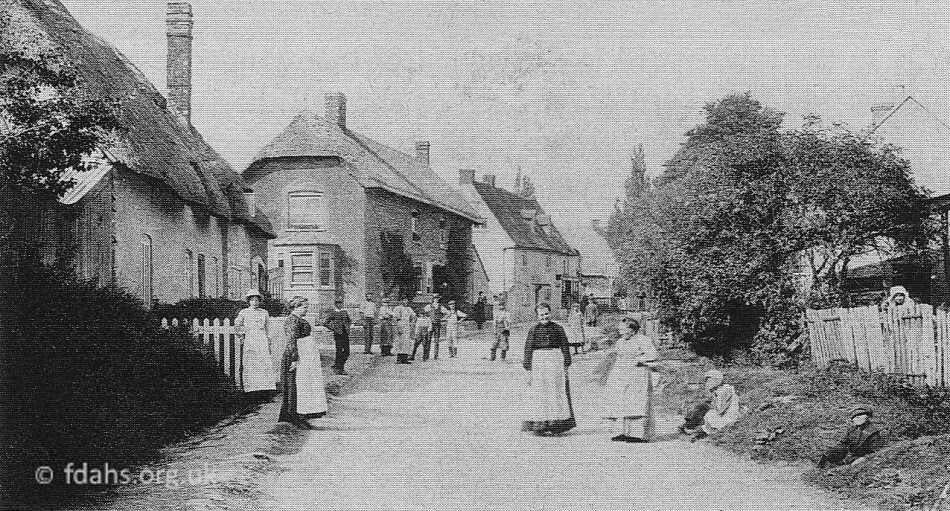 The High Street before 1906, looking down into the centre of the village. A crowd of people in front of Packers, the builders, on the left-hand side. The lady in the black dress with the white apron standing in the centre of the road is ‘Granny’ Maria Packford.
The High Street before 1906, looking down into the centre of the village. A crowd of people in front of Packers, the builders, on the left-hand side. The lady in the black dress with the white apron standing in the centre of the road is ‘Granny’ Maria Packford.
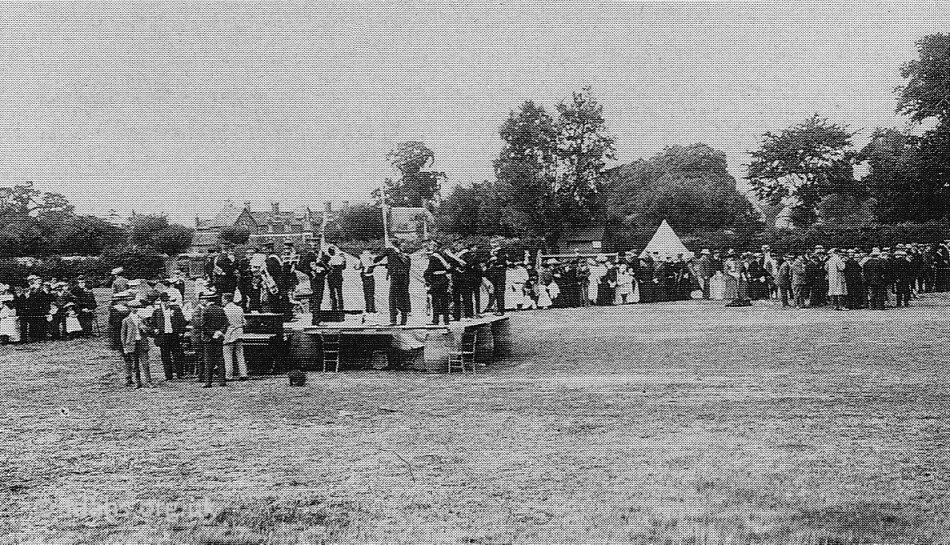 A Conservative Fete held in the early 1900s on the field where the new village hall now stands. The Kingston Lisle Brass Band is on the raised dais in the centre.
A Conservative Fete held in the early 1900s on the field where the new village hall now stands. The Kingston Lisle Brass Band is on the raised dais in the centre.
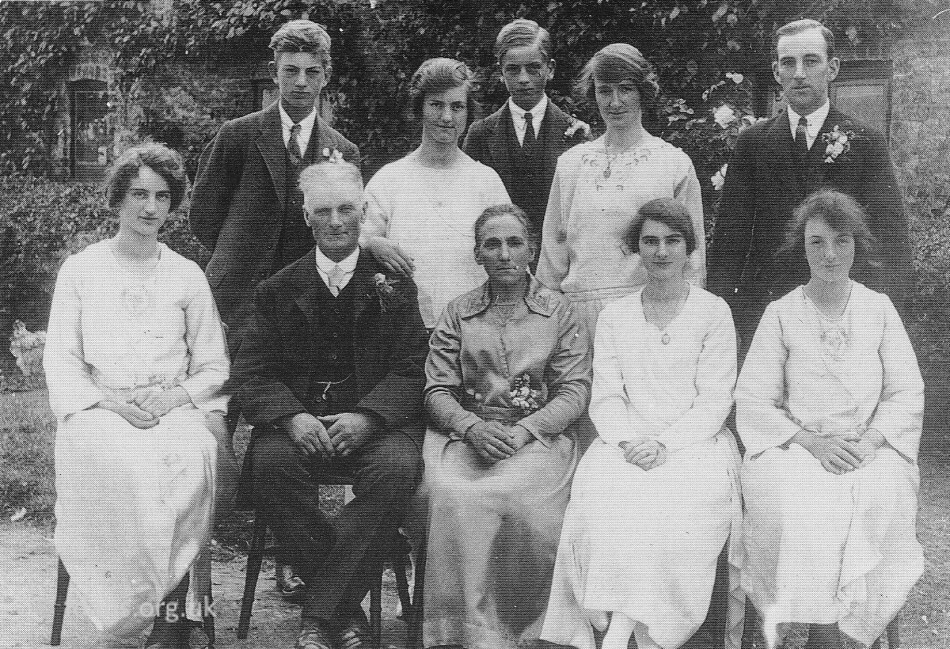 The Mildenhall family who lived on the Fawler road and were small farmers. Albert James Mildenhall and his wife Elizabeth had five sons (Herbert, Arthur, Albert who died in infancy, Albert, Wilfred) and four daughters (Margaret, Rosa, Dora, Florence). The eldest son rose through the ranks in the army to become an officer and was one of the first men to drive the new tanks in the First World War.
The Mildenhall family who lived on the Fawler road and were small farmers. Albert James Mildenhall and his wife Elizabeth had five sons (Herbert, Arthur, Albert who died in infancy, Albert, Wilfred) and four daughters (Margaret, Rosa, Dora, Florence). The eldest son rose through the ranks in the army to become an officer and was one of the first men to drive the new tanks in the First World War.
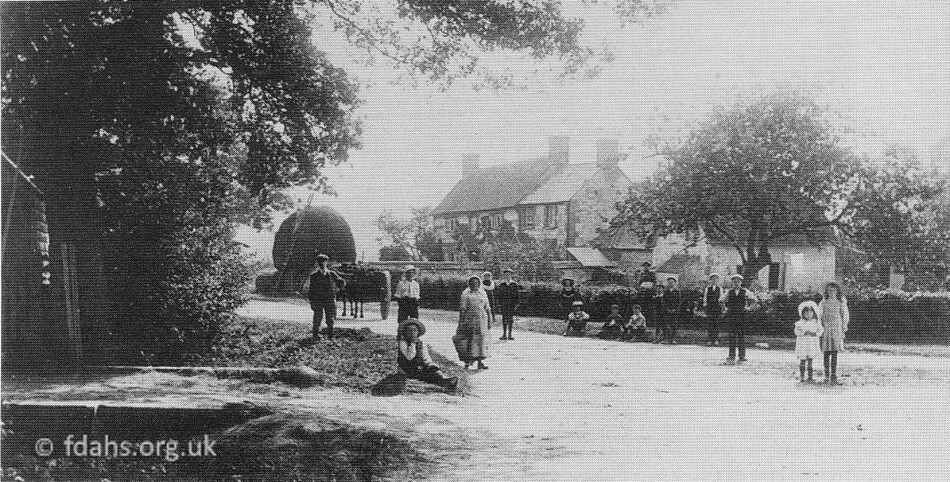 Shotover Corner c.1915. The photographer was standing in the High Street, looking towards the road leading to the White Horse Hill. The cottages in the background are now known as Shotover House. There have been very few changes in the view since this was taken.
Shotover Corner c.1915. The photographer was standing in the High Street, looking towards the road leading to the White Horse Hill. The cottages in the background are now known as Shotover House. There have been very few changes in the view since this was taken.
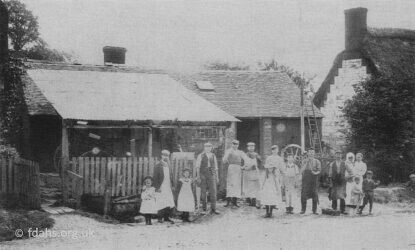 Uffington Forge. The Packer family, wheelwright and blacksmith, and staff in the High Street in front of the forge. The baby being carried was Queenie Weaver who became the cook at Uffington School.
Uffington Forge. The Packer family, wheelwright and blacksmith, and staff in the High Street in front of the forge. The baby being carried was Queenie Weaver who became the cook at Uffington School.
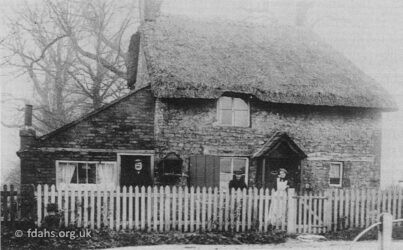 Westminster Bridge Cottage on Woolstone Road. The owners also had a small paddock across the road in which they raised pigs and hens.
Westminster Bridge Cottage on Woolstone Road. The owners also had a small paddock across the road in which they raised pigs and hens.
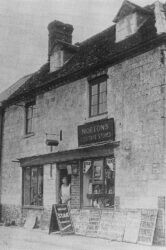 General Store and Post Office 1939. Mr and Mrs Pike’s daughter, Mrs Norton, standing in the doorway of her shop. She was the second generation of the family to own the shop. The billboards outside are all concerned with the events leading up to the Second World War.
General Store and Post Office 1939. Mr and Mrs Pike’s daughter, Mrs Norton, standing in the doorway of her shop. She was the second generation of the family to own the shop. The billboards outside are all concerned with the events leading up to the Second World War.
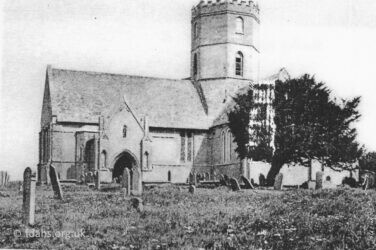 1880s. St Mary’s Church, Uffington, built in 1250 using sandstone under the auspices of Abingdon Abbey, and known as the “Cathedral of the Vale”. This imposing church for such a small village is a traditional Norman building and there are small crosses still visible that were carved into the wall during crusader times.
1880s. St Mary’s Church, Uffington, built in 1250 using sandstone under the auspices of Abingdon Abbey, and known as the “Cathedral of the Vale”. This imposing church for such a small village is a traditional Norman building and there are small crosses still visible that were carved into the wall during crusader times.
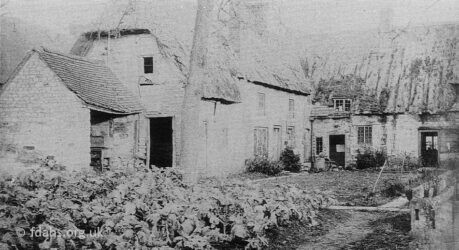 The Baker’s Arms. The rear of the Baker’s Arms taken from the lane leading to the church. It is thought to be the birthplace of John Hughes, forebear of Thomas Hughes of Tom Brown’s Schooldays fame. The only publican recorded6 was John Willis between 1907-1931.
The Baker’s Arms. The rear of the Baker’s Arms taken from the lane leading to the church. It is thought to be the birthplace of John Hughes, forebear of Thomas Hughes of Tom Brown’s Schooldays fame. The only publican recorded6 was John Willis between 1907-1931.
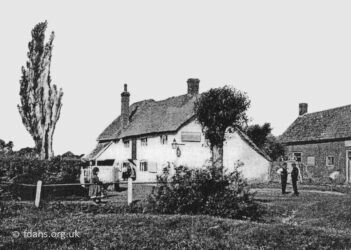 The Craven Arms in the early 1880s. A public house situated on Fernham Road. Publicans were recorded6 from 1847 Joseph Cook to 1931 Geo Cook. It is now a Grade II Listed Building and used as a private house.
The Craven Arms in the early 1880s. A public house situated on Fernham Road. Publicans were recorded6 from 1847 Joseph Cook to 1931 Geo Cook. It is now a Grade II Listed Building and used as a private house.
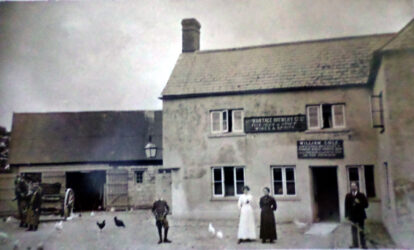 The White Horse public house dates back to at least 1851 when it was in the hands of publican Thomas Bye6. Standing outside in this photo7 are William & Eleanor Cole with daughter Elizabeth. William Cole was recorded as the publican between 1920-31, having taken over from Frank Smith who was recorded there in 1907.6 William Cole died in 1932. The building is said to have been “along the main road through Uffington, possibly later known by another name, and has since been demolished.“7
The White Horse public house dates back to at least 1851 when it was in the hands of publican Thomas Bye6. Standing outside in this photo7 are William & Eleanor Cole with daughter Elizabeth. William Cole was recorded as the publican between 1920-31, having taken over from Frank Smith who was recorded there in 1907.6 William Cole died in 1932. The building is said to have been “along the main road through Uffington, possibly later known by another name, and has since been demolished.“7
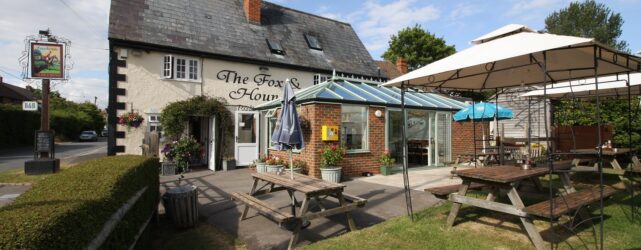 The Fox & Hounds is now the only public house still open in the village. It is situated on the High Street directly on route to the Uffington White Horse. It does not appear recorded like the other pubs, so possibly it was built or became a pub some time after 1931.
The Fox & Hounds is now the only public house still open in the village. It is situated on the High Street directly on route to the Uffington White Horse. It does not appear recorded like the other pubs, so possibly it was built or became a pub some time after 1931.
Uffington School
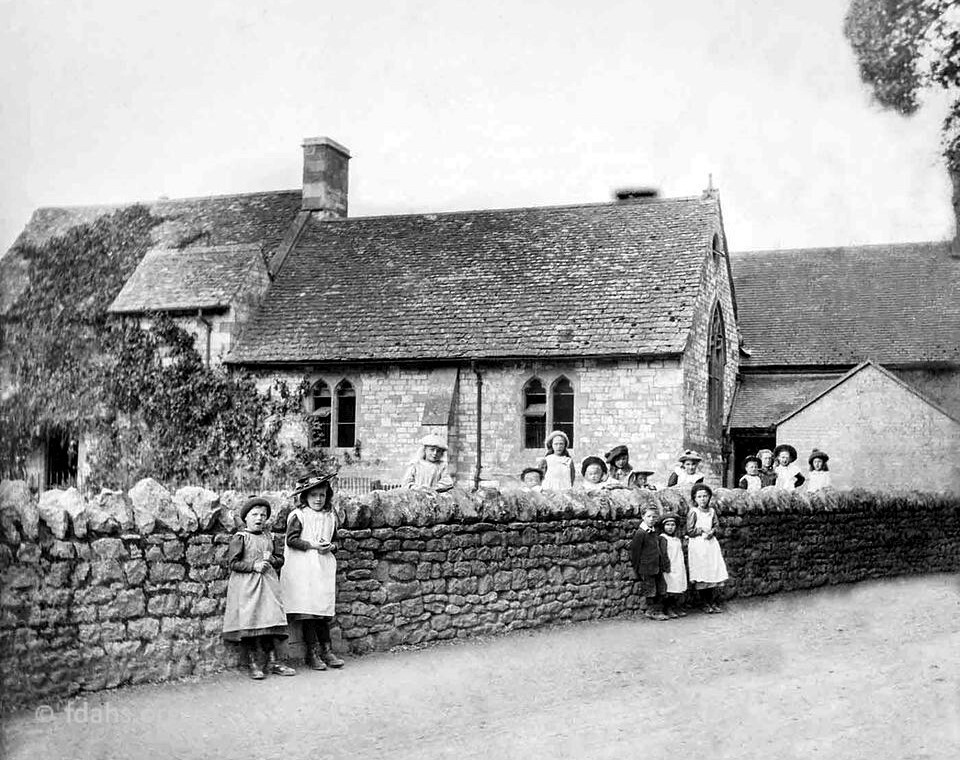 c1920s Uffington School in Broad Street, shown in the previous photo. It is the Church of England Primary School and still there today. The end building used to be the toilets with a wooden bench with buckets underneath.
c1920s Uffington School in Broad Street, shown in the previous photo. It is the Church of England Primary School and still there today. The end building used to be the toilets with a wooden bench with buckets underneath.
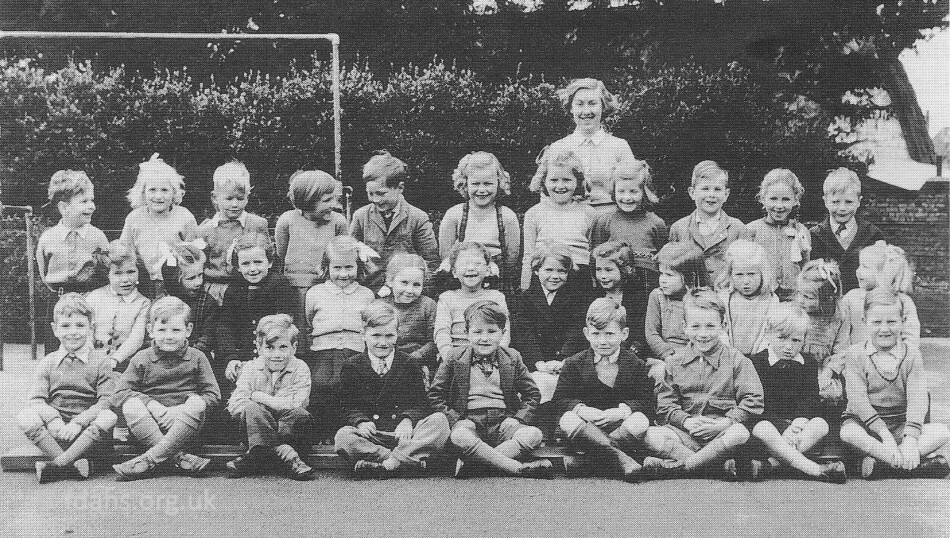 1952 Uffington School. A group with their teacher, Miss Jarrett, at the rear. Left to right, back row: George Switzer; Sheila Reynolds; Andy McBain; Jennifer Ritchings; Fred Smith; Barbara Gorton; Betty Chainey; ?; Clive Avenell; Carol Mattingley; James Collett. Middle row: Christine -; Brenda Avenell; Christine Whitehorn; Jane Attrill; Jackie Miller; ?; Kathy Wickell; Brenda Dainty; Valerie Avenell; ?; ?; Jemmy Trump. Front row: Freddie Challis; James Aldridge; ?; John Reynolds; Brian Chainey; David Connors; Anthony Keen; ‘Tiggy’ Packford; Alan Peacock.
1952 Uffington School. A group with their teacher, Miss Jarrett, at the rear. Left to right, back row: George Switzer; Sheila Reynolds; Andy McBain; Jennifer Ritchings; Fred Smith; Barbara Gorton; Betty Chainey; ?; Clive Avenell; Carol Mattingley; James Collett. Middle row: Christine -; Brenda Avenell; Christine Whitehorn; Jane Attrill; Jackie Miller; ?; Kathy Wickell; Brenda Dainty; Valerie Avenell; ?; ?; Jemmy Trump. Front row: Freddie Challis; James Aldridge; ?; John Reynolds; Brian Chainey; David Connors; Anthony Keen; ‘Tiggy’ Packford; Alan Peacock.
Uffington Railway Station
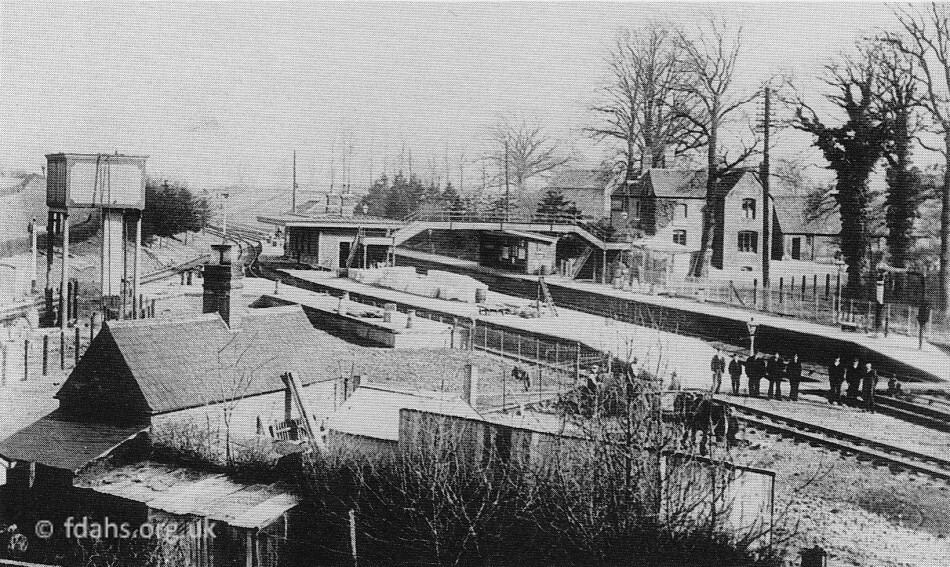 Uffington Railway Station c.1897. The photographer is standing on the road bridge looking left and down onto the station and workshop buildings. The main line of the Great Western Railway from London to Bristol was opened in 1841. The single track branch line to Faringdon Railway Station, that was opened in 1864, is on the left behind the water tower. Water was piped under the Faringdon track to the water tower from a spring on Ringdale Hill. The Junction Hotel is on the right in the background. The staff are lined up on the crossing between the ‘up’ and ‘down’ main line platforms. The branch line to Faringdon and Uffington Station were closed in December 1963. The houses shown in the photo on both sides of the railway are still there but the branch line, station buildings and platforms are long gone.
Uffington Railway Station c.1897. The photographer is standing on the road bridge looking left and down onto the station and workshop buildings. The main line of the Great Western Railway from London to Bristol was opened in 1841. The single track branch line to Faringdon Railway Station, that was opened in 1864, is on the left behind the water tower. Water was piped under the Faringdon track to the water tower from a spring on Ringdale Hill. The Junction Hotel is on the right in the background. The staff are lined up on the crossing between the ‘up’ and ‘down’ main line platforms. The branch line to Faringdon and Uffington Station were closed in December 1963. The houses shown in the photo on both sides of the railway are still there but the branch line, station buildings and platforms are long gone.
Uffington Canal Wharf
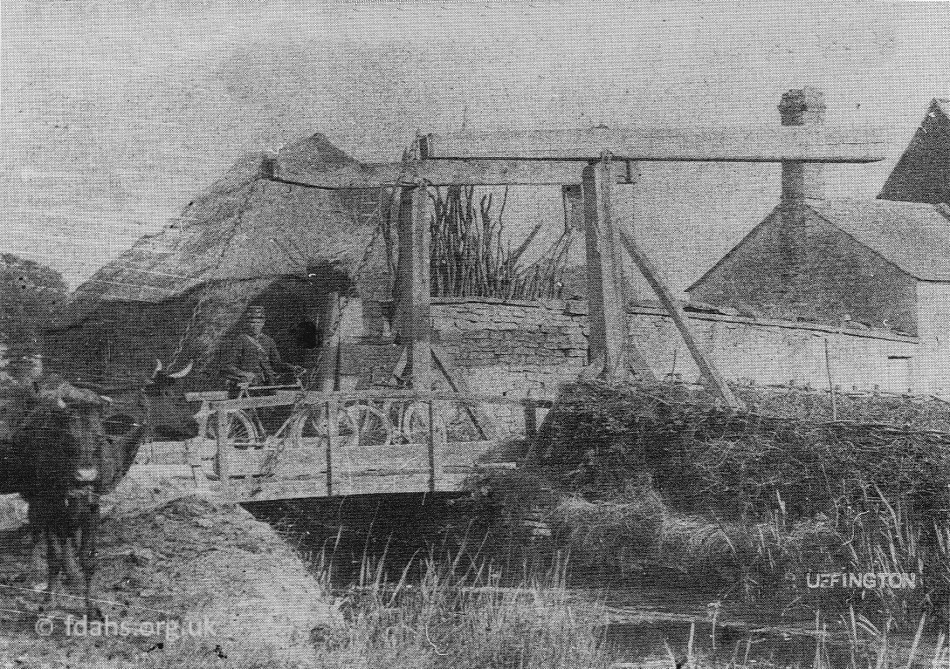 Uffington Wharf c.l907. The bridge over the Wilts and Berks Canal on the Fernham/Uffington road at what is now Wharf Farm. A postman with a bicycle is standing on the bridge. The photographer is on the Fernham bank. In the event of a barge wishing to pass along the canal, the bridge was lifted by beams which were counter-weighted so that it would stay in the upright position. If anyone, coming along from the Fernham direction, wished to cross the bridge and it was still upright, there was a long pole with a hook on the end which was hooked onto a ring at the end of the bridge and the person heaved the bridge down. The building in the background was called Wharf Farm and was occupied by Mr Jenkins. He was a haulier with a team of white horses and worked for the Astor Estate. Mr Jenkins also ran a small farm. He was the last man to have a barge at Uffington, using it for hauling coal from Swindon to Wantage on the small section of the canal that was still in use. The barge was last used to transport hay to the farm. It was then left to rot in the water and its remains are still in the base of the canal which has now been filled in and a modern bungalow built on top.
Uffington Wharf c.l907. The bridge over the Wilts and Berks Canal on the Fernham/Uffington road at what is now Wharf Farm. A postman with a bicycle is standing on the bridge. The photographer is on the Fernham bank. In the event of a barge wishing to pass along the canal, the bridge was lifted by beams which were counter-weighted so that it would stay in the upright position. If anyone, coming along from the Fernham direction, wished to cross the bridge and it was still upright, there was a long pole with a hook on the end which was hooked onto a ring at the end of the bridge and the person heaved the bridge down. The building in the background was called Wharf Farm and was occupied by Mr Jenkins. He was a haulier with a team of white horses and worked for the Astor Estate. Mr Jenkins also ran a small farm. He was the last man to have a barge at Uffington, using it for hauling coal from Swindon to Wantage on the small section of the canal that was still in use. The barge was last used to transport hay to the farm. It was then left to rot in the water and its remains are still in the base of the canal which has now been filled in and a modern bungalow built on top.
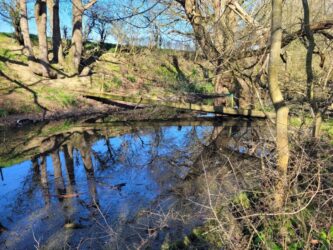 The Wilts and Berks Canal once linked the Kennet and Avon Canal near Melksham with the Thames at Abingdon. The canal was out of use by 1914 and fell into disrepair with some sections filled in and built over. Since then some sections have been resurrected by volunteers, who have refilled sections, restored locks, and created wildlife and amenity areas. In 2022, the canal trust completed the purchase of Uffington Gorse (photo) consisting of 9 acres of public amenity woodland and 200m of canal. Uffington Gorse is an area of thick wordland located just off Station Road, halfway between Uffington and Baulking.
The Wilts and Berks Canal once linked the Kennet and Avon Canal near Melksham with the Thames at Abingdon. The canal was out of use by 1914 and fell into disrepair with some sections filled in and built over. Since then some sections have been resurrected by volunteers, who have refilled sections, restored locks, and created wildlife and amenity areas. In 2022, the canal trust completed the purchase of Uffington Gorse (photo) consisting of 9 acres of public amenity woodland and 200m of canal. Uffington Gorse is an area of thick wordland located just off Station Road, halfway between Uffington and Baulking.
Uffington White Horse
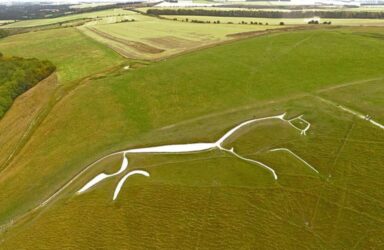 Uffington White Horse. The village sees thousands of visitors a year passing by on their way to look at the country’s most famous Bronze Age White Horse carved in the turf of the Berkshire Downs about 2 miles to the south of the village. It is by far the oldest of the white horse figures in Britain, an estimated 3000 years old. There are many speculations as to why it was carved on the top of the hill where it can only best be seen properly from above. Some say it is not a horse but a dragon, indeed the road leading up to it is called ‘Dragon Hill Road’, named after the small but very distinct hill below it where Saint George is said to have slain the dragon. The site is now owned and managed by the National Trust and is a scheduled monument.
Uffington White Horse. The village sees thousands of visitors a year passing by on their way to look at the country’s most famous Bronze Age White Horse carved in the turf of the Berkshire Downs about 2 miles to the south of the village. It is by far the oldest of the white horse figures in Britain, an estimated 3000 years old. There are many speculations as to why it was carved on the top of the hill where it can only best be seen properly from above. Some say it is not a horse but a dragon, indeed the road leading up to it is called ‘Dragon Hill Road’, named after the small but very distinct hill below it where Saint George is said to have slain the dragon. The site is now owned and managed by the National Trust and is a scheduled monument.
Up until the late 19th century, the horse was scoured every seven years by local people as part of a rural festival sponsored by the lord of the manor. The Reading Mercury reported thirty thousand people present at the 1780 scouring. Among the many attractions were cart horse races, ‘ridden by carters in smocks without saddles.’ ‘A good hat to be run for by men in sacks.’ ‘A flitch of bacon to be run for by asses.’ ‘A cheese to be run for down the White Horse Manger.’ and ‘A jingling match by eleven blindfold men, one unmasked and hung with bells, for a pair of buckskin breeches.’. The story of the 1857 scouring is colourfully told by local author Thomas Hughes, in his book ‘The Scouring of the White Horse‘.5 Scouring lasted two days, and was a festive occasion for a family day out with some spirited merrymaking. The high spot was the pig race in which thirty runners pursued a pig over White Horse Hill.4
Uffington Castle
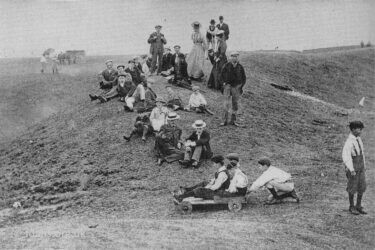 Uffington Castle on an August Monday in the 1890s. The people were brought up the hill by the horse-drawn vehicles in the background. Note the children playing with a cart in the foreground. Uffington Hill was the usual destination for outings at this time. Uffington Castle was an early Iron Age fort located on the top of the hill above the White Horse and later occupied by the Romans. What remains today is a very large flat area that is surrounded by two high earth banks separated by a deep ditch.
Uffington Castle on an August Monday in the 1890s. The people were brought up the hill by the horse-drawn vehicles in the background. Note the children playing with a cart in the foreground. Uffington Hill was the usual destination for outings at this time. Uffington Castle was an early Iron Age fort located on the top of the hill above the White Horse and later occupied by the Romans. What remains today is a very large flat area that is surrounded by two high earth banks separated by a deep ditch.
References:
- Much of this content was taken from The Changing Faces of Faringdon and Surrounding Villages – Book 1 p121-128 by Rosemary Church, Jim Brown, Millie Bryan and Beryl Newman. Robert Boyd Publications 1999 – now out of print. Most of the photos were scanned directly from the book and some from the original photos, where available.
- The English Place-Name Society – https://epns.nottingham.ac.uk/search
- Uffington’s Cutting Edge – Faringdon Folly p13 October 1992.
- Curiosities of Oxfordshire – A County Guide to the Unusual by Edward Gill, p100. S.B.Publications 1995.
- The Scouring of the White Horse or The Long Vacation Ramble of a London Clerk. Thomas Hughes 1859.
- Public Houses, Inns & Taverns of Berkshire – https://pubshistory.com/Berkshire/index.shtml
- Photo and information provided by Marilyn Harrison, whose grandmother and great grandparents are standing outside their pub.
